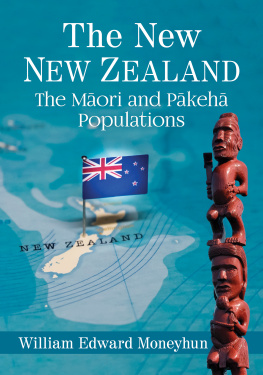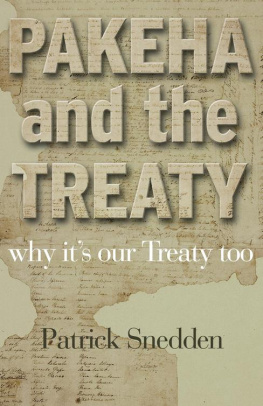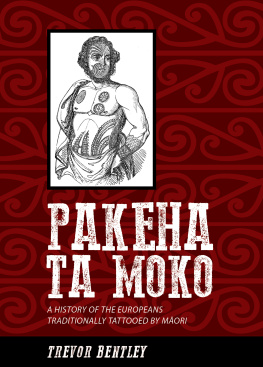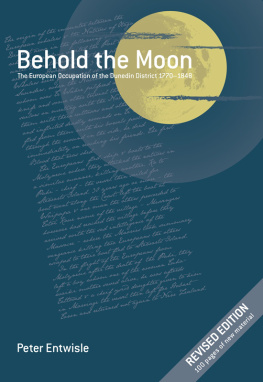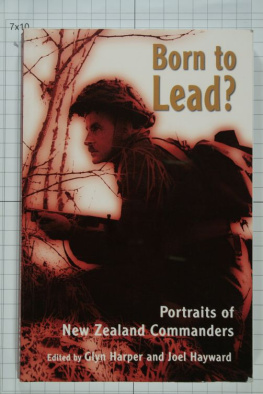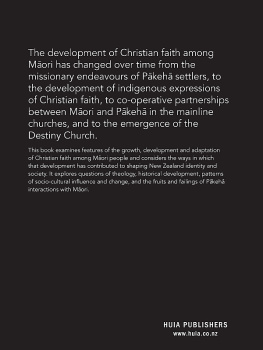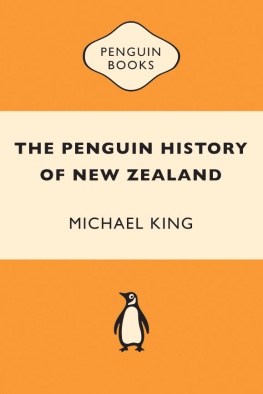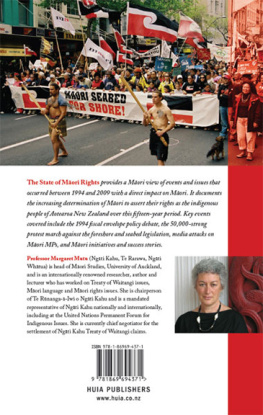William Edward Moneyhun - The New New Zealand: The Maori and Pakeha Populations
Here you can read online William Edward Moneyhun - The New New Zealand: The Maori and Pakeha Populations full text of the book (entire story) in english for free. Download pdf and epub, get meaning, cover and reviews about this ebook. year: 2020, publisher: McFarland & Company, genre: Home and family. Description of the work, (preface) as well as reviews are available. Best literature library LitArk.com created for fans of good reading and offers a wide selection of genres:
Romance novel
Science fiction
Adventure
Detective
Science
History
Home and family
Prose
Art
Politics
Computer
Non-fiction
Religion
Business
Children
Humor
Choose a favorite category and find really read worthwhile books. Enjoy immersion in the world of imagination, feel the emotions of the characters or learn something new for yourself, make an fascinating discovery.
- Book:The New New Zealand: The Maori and Pakeha Populations
- Author:
- Publisher:McFarland & Company
- Genre:
- Year:2020
- Rating:3 / 5
- Favourites:Add to favourites
- Your mark:
- 60
- 1
- 2
- 3
- 4
- 5
The New New Zealand: The Maori and Pakeha Populations: summary, description and annotation
We offer to read an annotation, description, summary or preface (depends on what the author of the book "The New New Zealand: The Maori and Pakeha Populations" wrote himself). If you haven't found the necessary information about the book — write in the comments, we will try to find it.
The New New Zealand: The Maori and Pakeha Populations — read online for free the complete book (whole text) full work
Below is the text of the book, divided by pages. System saving the place of the last page read, allows you to conveniently read the book "The New New Zealand: The Maori and Pakeha Populations" online for free, without having to search again every time where you left off. Put a bookmark, and you can go to the page where you finished reading at any time.
Font size:
Interval:
Bookmark:

The New New Zealand

McFarland & Company, Inc., Publishers
Jefferson, North Carolina
Figures 2, 3, and 5 were downloaded from https://www.photosforwork.com . They are reproduced under Creative Commons license: http://creativecommons.org/licenses/by/2.0 . Use of these photos does not imply any endorsement by its licensor.
Library of Congress Cataloguing-in-Publication Data
Names: Moneyhun, William Edward, 1946 author.
Title: The new New Zealand : the Mori and Pkeh populations / William Edward Moneyhun.
Description: Jefferson : McFarland & Company, Inc., Publishers, 2020. | Includes bibliographical references and index.
Identifiers: LCCN 2019049529 | ISBN 9781476677002 (paperback) ISBN 9781476638348 (ebook)
Subjects: LCSH: New ZealandRace relations. | BiculturalismNew Zealand.
Classification: LCC DU422.5 .M66 2020 | DDC 305.800993dc23
LC record available at https://lccn.loc.gov/2019049529
British Library cataloguing data are available
ISBN (print) 978-1-4766-7700-2
ISBN (ebook) 978-1-4766-3834-8
2020 William Edward Moneyhun. All rights reserved
No part of this book may be reproduced or transmitted in any form or by any means, electronic or mechanical, including photocopying or recording, or by any information storage and retrieval system, without permission in writing from the publisher.
On the cover: Front cover images 2020 Shutterstock
Printed in the United States of America
McFarland & Company, Inc., Publishers
Box 611, Jefferson, North Carolina 28640
www.mcfarlandpub.com
To Teeli
How does one acknowledge all who have contributed to the publication of a book when the task entails so many people in so many ways? The popular metaphor of countless tributaries flowing from myriad directions down, around, and through diverse mountains to feed a stream of context appropriate depth, width, energy, and clarity is popular for a reason. In the present frame of reference it bespeaks academic influences, academic advice, religious inspirations, cultural relationships and courtesies, personal associations, and personal assistance; persons actively involved and others who did not, and do not, realize their contribution; persons who passed away before this project was ever a thought in mind, others who passed while it was in progress, and still others with whom relationships continue.
This book is the product of seven years of study and research through the Graduate Theological Foundation of Mishawaka, Indiana. I must express my deep appreciation for the encouragement and support of Dr. John H. Morgan, who supervised my doctoral thesis, which has culminated in this present work. I must also express my gratitude for and indebtedness to his keen academic perceptiveness and expertise; especially his understanding and presentation of the origins of human religious consciousness and his discernment and explication, first published in 1977, of a particular similarity in the anthropology of American anthropologist Clifford Geertz and the philosophical theology of German-American theologian and philosopher of religion Paul Tillich. In fact, in many respects this book applies Dr. Morgans observations to a particular cultural setting.
Nevertheless, my primary acknowledgment must be to Teeli, Ms. Linda Jurd, my Kiwi friend and confidant, to whom this book is dedicated. Without her gracious invitation to visit her wonderful country; her faultless hospitality while I was there; and her delightful, discerning, and gentle friendship through the years; this project would likely never have been conceived.
Other contributors that I must mention include those providing publication advice (sometimes over lunch, coffee, or iced tea), formal education in the classroom (the United States, Great Britain, and Aotearoa/New Zealand), one-on-one education in the style of e-tutorials, assistance with travel arrangements, help with converting computer files, care for house and grounds (especially brother-in-law Gary and my late sister Pat), and management of what business there was to manage while I was away studying, researching, visiting, partying (only occasionally), and otherwise hobnobbing with virtually any hobnobbable person available.
I do, of course, take full responsibility for any and all deficiencies in the pages that follow.
This pronunciation guide is intended for readers who have had little or no exposure to the Mori language. While it is not a complete treatment and cuts corners in many ways, it should be adequate as an aid for such persons to comfortably peruse this book.
As in English, the Mori language has five vowels: a , e , i , o , and u , and each has a long and short sound. A macron appearing over a letter (, , , , and ) indicates a long vowel; short vowels have no macron ( a , e , i , o , and u ). The macron is quite important because its presence sometimes indicates the plural form of a word while in other instances it differentiates between word meanings. For example, tipuna is ancestor; tpuna is ancestors; and tpna (a word borrowed from the English language) is teaspoon. Even though contextual usage would be an indicator of the writers or speakers intent, we must not undervalue either accurate spelling or proper enunciation.
The more curious and adventurous readers will find that an internet search turns up a number of resources which use English word examples for pronouncing Mori vowels; one set of words for the long vowels and a separate set for the short vowels. Those who peruse these aids should keep in mind that their authors, when speaking English, may voice their vowels somewhat differently than people from other places. Therefore, while the examples may adequately communicate proper Mori vowel sounds to persons who articulate vowels in the same way as do the authors of the aids, they may be of less help to persons who voice vowels differently. Unless the resource includes a feature which audibly sounds the vowels, the effectiveness of the examples may be less than optimum. Moreover, there appears to be a lack of consistency among some of the online resources.
Consequently, it may be advantageous for most of the readers of this book (who might not have access to either someone who speaks Mori or audible internet files) to use the following pronunciations which do not strictly differentiate between the articulation of long and short vowels except to hold the long vowel a count longer than the short vowel; specifically, aa as compared to a; ee as compared to e, ii as compared to i, oo as compared to o, and uu as compared to u. But keep in mind that they are proffered by a speaker of Midwestern-Midsouthern American English.
- Pronounce a like a in balm.
- Pronounce e like e in egg.
- Pronounce i like ee in beep.
- Pronounce o like o in home.
- Pronounce u like oo in spoon.
There are also diphthongs in the Mori language. If you pronounce them gliding the first vowel sound into the second in a way that retains the quality of each letter in the diphthong, you should be in the ballpark, e.g., pronounce ao to rhyme with cow and au to rhyme with toe.
The Mori language has only ten consonants: h , k , m , n , p , r , t , w , ng , and wh . Actually, two are digraphs, i.e., two letters which represent one sound. You may enunciate the consonants as you would in English with the exception of the digraphs.
Font size:
Interval:
Bookmark:
Similar books «The New New Zealand: The Maori and Pakeha Populations»
Look at similar books to The New New Zealand: The Maori and Pakeha Populations. We have selected literature similar in name and meaning in the hope of providing readers with more options to find new, interesting, not yet read works.
Discussion, reviews of the book The New New Zealand: The Maori and Pakeha Populations and just readers' own opinions. Leave your comments, write what you think about the work, its meaning or the main characters. Specify what exactly you liked and what you didn't like, and why you think so.

